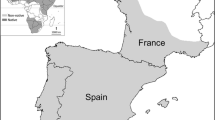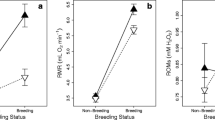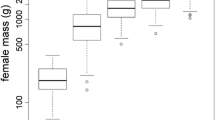Abstract
The contribution of the maternal environment (gestational weight gain, month of birth, and litter size) to the formation and realization of the reproductive potential of adjacent European water vole generations has been studied for years in the natural population and in captivity. The accumulation of body fat and other reserves during pregnancy plays an essential role in the regulation of reproductive processes. Realization of the reproductive potential of females, growth rate, and the sexual maturation of the offspring depends on the ability of the mothers to properly utilize the energy reserves of their body both during pregnancy and at the next stage of the reproduction cycle, lactation.
Similar content being viewed by others
References
Bauman, D.E. and Currie, W.B., Partitioning of Nutrients during Pregnancy and Lactation: A Review of Mechanisms Involving Homeostasis and Homeorhesis, J. Dairy Sci., 1980, vol. 63, pp. 1514–1529.
Belyaev, D.K., The Theoretical Basis and Practical Aspects of Using Photoperiodism in the Breeding of Fur-Bearing Animals, in Svetovoi faktor v povyshenii produktivnosti pushnykh zverei (The Light Factor in Increasing the Productivity of Fur-Bearing Animals), Moscow, 1976, pp. 7–30.
Bernardo, J., Maternal Effects in Animal Ecology, Am. Zool., 1996, vol. 36, pp. 83–105.
Boonstra, R., Life History Variation in Maturation in Fluctuating Meadow Vole Populations (Microtus pennsylvanicus), Oikos, 1989, vol. 54, pp. 265–274.
Boyd, I.L., State-Dependent Fertility in Pinnipeds: Contrasting Capital and Income Breeders, Funct. Ecol., 2000, vol. 14, pp. 623–630.
Bronson, F.H. and Rissman, E.F., The Biology of Puberty, Biol. Rev., 1986, vol. 61, pp. 157–195.
Chrousos, G.P., Torpy, D.J., and Gold, P.W., Interactions between the Hypothalamic-Pituitary Axis and the Female Reproductive System: Clinical Implications, Ann. Intern. Med., 1998, vol. 129, pp. 229–240.
Ebling, E.J.P. and Foster, D.L., Pineal Melatonin Rhythms and the Timing of Puberty in Mammals, Experientia, 1989, vol. 45, pp. 946–954.
Evsikov, V.I., Osetrova, T.D., Kondrina, L.P., and Belyaev, D.K., Genetics of Fertility of Animals. V. Weight of Mice of BALB and C57Bl Lines and Their Reciprocal Hybrids and Its Relation to Fertility, Genetika, 1973, vol. 9, no. 8, pp. 70–84.
Evsikov, V.I., Moshkin, M.P., Gerlinskaya, L.A., and Nazarova, G.G., Realization of the Reproductive Potential and Stress in the Abundance Cycle of Water Voles, in Ekologiya populyatsii (Ecology of Populations), Moscow, 1991, pp. 213–228.
Evsikov, V.I., Moshkin, M.P., and Gerlinskaya, L.A., Population Ecology of the Water Vole (Arvicola terrestris L.) in Western Siberia. III. Stress and Reproduction in the Population Cycle, Sib. Ekol. Zh., 1999a, no. 1, pp. 79–88.
Evsikov, V.I., Nazarova, G.G., and Rogov, V.G., Population Ecology of the Water Vole (Arvicola terrestris L.) in Western Siberia. I. Reproduction of Females, Polymorphic in Coat Color at Different Phases of the Population Size Dynamics, Sib. Ekol. Zh., 1999b, no. 1, pp. 59–68.
Evsikov, V.I., Nazarova, G.G., and Muzyka, V.Yu., Body Condition and Reproductive Characteristics of Female Water Voles (Arvicola terrestris L.), Russ. J. Ecol., 2008, vol. 39, no. 6, pp. 414–417.
Frisch, R.E., Body Fat, Puberty and Fertility, Biol. Rev., 1984, vol. 59, pp. 161–188.
Fusco, G. and Minelli, A., Phenotypic Plasticity in Development and Evolution: Facts and Concepts, Philos. Trans. R. Soc. London B, 2010, vol. 365, pp. 547–556.
Gittleman, J.Z. and Thompson, S.D., Energy Allocation in Mammalian Reproduction, Am. Zool., 1988, vol. 28, pp. 863–875.
Glazier, D.S., Is Fatter Fitter? Body Storage and Reproduction in Ten Populations of the Freshwater Amphipod Gammarus minus, Oecologia, 2000, vol. 122, pp. 335–345.
Glen, P., Food, Sex, Time and Effort in Small Mammals: Energy Allocation Strategies for Survival and Reproduction, Behavior, 1990, vol. 114, pp. 191–205.
Gliwicz, J., Life History of Voles: Growth and Maturation in Seasonal Cohorts of the Root Vole, Misc. Zool., 1996, vol. 19, no. 1, pp. 1–12.
Gueorguiev, M. and Korbonits, M., Leptin and Puberty: A Review, Pituitary, 2001, vol. 4, pp. 79–86.
Hamilton, G.D. and Bronson, F.H., Food Restriction and Reproductive Development in Wild House Mice, Biol. Reprod., 1985, vol. 32, pp. 773–778.
Jnsson, I.K., Capital and Income Breeding as Alternative Tactics of Resource Use in Reproduction: Metabolic Fuels Hypothesis, Oikos, 1997, vol. 78, pp. 57–66.
Kirkwood, J.K., A Limit to Metabolisable Energy in Mammals and Birds, Comp. Biochem. Physiol., 1983, vol. 75A, pp. 1–3.
Klochkov, D.V., Gulevich, R.G., and Trapezov, O.V., Photoperiodic Signal as a Key Factor in the Organism-Environment Relationship, Inform. Vestnik VOGiS, 2010, vol. 4, no. 4, pp. 729–746.
Lonhard, M., Lesage, J., Croix, D., et al., Effects of Perinatal Maternal Food Restriction on Pituitary-Gonadal Axis and Plasma Leptin Level in Rat Pup at Birth and Weaning and on Timing of Puberty, Biol. Reprod., 2003, vol. 68, pp. 390–400.
Muzyka, V.Yu., Nazarova, G.G., Potapov, M.A., et al., Effect of Hydrological Conditions on the Intraspecific Competition, Structure of Settlements, and Reproduction in the Water Vole Arvicola terrestris, Sib. Ekol. Zh., 2010, no. 5, pp. 827–833.
Nazarova, G.G., Maternal Effects on the Offspring Fitness and the Population Size, Extended Abstract of Doctoral (Biol.) Dissertation, Novosibirsk, 2008.
Nazarova, G.G. and Evsikov, V.I., Effect of Feeding Conditions on the Survival of Offspring, Their Reproductive Characteristics, and Sex Ratio in the Water Vole (Arvicola terrestris), Zool. Zh., 2000, vol. 79, no. 3, pp. 58–63.
Nazarova, G.G. and Evsikov, V.I., Sexual Maturation of Daughters Depends on the Mother’s Body Condition during Pregnancy: an Example of the Water Vole Arvicola terrestris L., Dokl. Biol. Sci., 2007, vol. 412, pp. 53–55.
Nazarova, G.G. and Evsikov, V.I., Effect of Mother’s Physical Condition during Pregnancy and Lactation on Postnatal Growth and Reproductive Success of Offspring in Water Vole Arvicola terrestris L., Russ. J. Dev. Biol., 2008, vol. 39, no. 2, pp. 125–133.
Olenev, G.V., Alternative Types of Ontogeny in Cyclomorphic Rodents and Their Role in Population Dynamics: An Ecological Analysis, Russ. J. Ecol., 2002, vol. 33, no. 5, pp. 321–330.
Ovchinnikova, L.E., The Role of Trophic Factors in the Regulation of Abundance of Water Voles (Arvicola terrestris L.), Extended Abstract of Candidate’s (Biol.) Dissertation, Novosibirsk: ISiEZh SO RAN, 2000.
Pianka, E., Evolyutsionnaya ekologiya (Evolutionary Ecology), Moscow: Mir, 1981.
Randolph, P.A., Randolph, J.C., Mattingly, K., and Foster, M.M., Energy Costs of Reproduction in the Cotton Rat (Sigmodon hispidus), Ecology, 1977, vol. 58, pp. 31–45.
Reinhold, K., Maternal Effects and the Evolution of Behavioral and Morphological Characters: A Literature Review Indicates the Importance of Extended Maternal Care, J. Hered., 2002, vol. 93, pp. 400–405.
Rossiter, M.C., Incidence and Consequences of Inherited Environmental Effects, Annu. Rev. Ecol. Syst., 1996, vol. 27, pp. 451–476.
Schulz, L.C. and Widmaier, E.P., The Effect of Leptin on Mouse Trophoblast Cell Invasion, Biol. Reprod., 2004, vol. 71, pp. 1963–1967.
Schwarz, S.S., Pokrovski, A.V., Istchen, V.C., et al., Biological Peculiarities of Seasonal Generations of Rodents, with Special Reference to the Problem of Senescence in Mammals, Acta Theriologica, 1964, vol. 8, no. 1, pp. 1–43.
Shilov, I.A., General Principles of Ecological Adaptation, Biol. Nauki. Nauch. Dokl. Vyssh. Shkoly, 1977, no. 10, pp. 55–62.
Schmalhausen, I.I., Puti i zakonomernosti evolyutsionnogo protsessa. Izbr. tr. (Ways and Patterns of the Evolutionary Process: Collected Papers), Moscow: Nauka, 1983.
Trivers, R.L., Parent-Offspring Conflict, Am. Zool., 1974, vol. 14, pp. 249–264.
Waddington, K.H., Basic Biological Concepts, in Na puti k teoreticheskoi biologii. I. Prolegomeny (Towards a Theoretical Biology. I. Prolegomena), Moscow: Mir, 1970, pp. 11–38.
Weiner, J., Limits to Energy Budget and Tactics in Energy Investments during Reproduction in the Djungarian Hamster (Phodopus sungorus Pallas 1770), Symp. Zool. Soc. Lond., 1987, vol. 57, pp. 167–187.
Weiner, J., Metabolic Constraints to Mammalian Energy Budgets, Acta Theriol., 1989, vol. 34.
Woodside, B., Wilson, R., Chee, P., and Leon, M., Resource Partitioning during Reproduction in the Norway Rat, Science, 1981, vol. 2, pp. 76–77.
Yakovleva, T.V., Bazhan, N.M., and Makarova, E.N., Effects of Food Deprivation in Early Pregnancy on the Development of Ovaries and Adrenals in Female Progeny of the Water Vole (Arvicola terrestris), Comp. Biochem. Physiol. C. Pharmacol. Toxicol. Endocrinol., 1997, vol. 116, pp. 103–109.
Zambrano, E., Rodriguez-Gonzalez, G.L., Guzman, C., et al., A Maternal Low Protein Diet during Pregnancy and Lactation in the Rat Impairs Male Reproductive Development, J. Physiol., 2005, vol. 563, pp. 275–284.
Author information
Authors and Affiliations
Corresponding author
Additional information
Original Russian Text © G.G. Nazarova, V.I. Evsikov, 2011, published in Vavilovskii Zhurnal Genetiki i Selektsii, 2011, Vol. 15, No. 3, pp. 485–492.
Rights and permissions
About this article
Cite this article
Nazarova, G.G., Evsikov, V.I. The evolutionary ecology of animal fertility: The fitness of progeny is determined by their prenatal development (according to the example of the European water vole, Arvicola terrestris L.). Russ J Genet Appl Res 2, 23–28 (2012). https://doi.org/10.1134/S2079059712010121
Published:
Issue Date:
DOI: https://doi.org/10.1134/S2079059712010121




